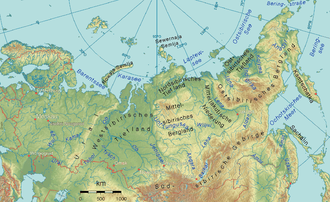East Siberian mountain country
The East Siberian highlands ( Russian Восточно-Сибирское нагорье ) is one of the eight large Russian landscapes of Siberia . It is part of the greater Russian Far East region in northeast Asia .
The highest peak of the East Siberian mountainous region is the 3003 m high Pobeda in the Tscherski Mountains .
Geographical location
Within northeast Russia, which is located between the Arctic Ocean and the Pacific Ocean and their marginal seas, the Laptev Sea , the East Siberian Sea , the Chukchi Sea , the Bering Sea and the Okhotsk Sea , the East Siberian mountainous region lies on the expansive and highly landscaped eastern and northeastern part of the Asian continent .
It essentially comprises several independent high mountains that, viewed from the west, extend from the Central Yakut lowland with the extensive Lena valley for about 2,700 km to Cape Deschnjow . In the north it abuts the u- or v-shape in the mountains in East Siberian reaching East Siberian lowland . In the southwest it goes seamlessly into the South Siberian Mountains .
Surname
Because the East Siberian mountain country extends beyond the actual borders of Siberia in the east and northeast , it should actually be called Northeast Asian or Northeast Russian mountain country.
Mountains

The mountains of the East Siberian Mountains include (from west to east):
- Verkhoyansk Mountains
- Kular Mountains
- Ulachan-Sis (Jana Indigirka Lowlands)
- Kjundjuljun Mountains
- Oymyakon highlands
- Suntar Chajata Mountains
- Tscherski Mountains
- Sette Daban
- Jugdschur Mountains
- Moma Mountains
- Jukagiren Plateau
- Kolyma Mountains
- Anjui Mountains
- Koryak Mountains
- Anadyr plateau
- Anadyr Mountains
- Chukotka highlands
In addition, although they are more in the East Siberian lowlands , the following can be counted :
Rivers
These rivers originate within the East Siberian Mountains (west-east direction):
places
The East Siberian highlands are only sparsely populated, there are no large cities except Yakutsk . On the distant Pacific coast , the city of Magadan is located on the Sea of Okhotsk .


